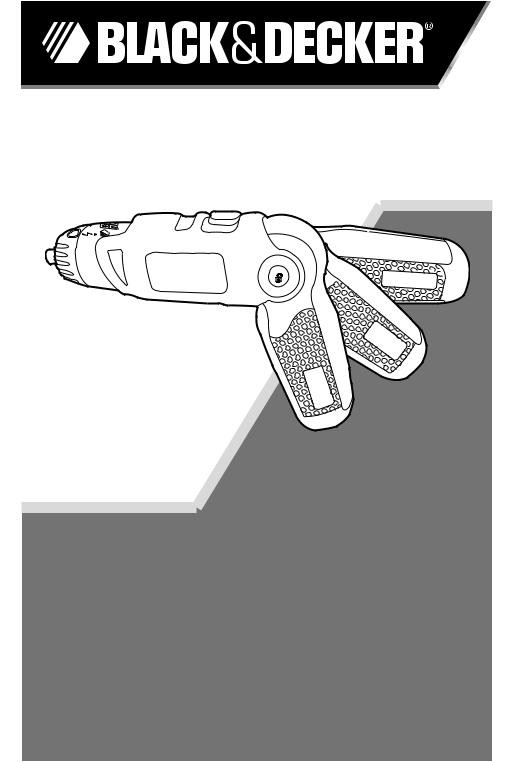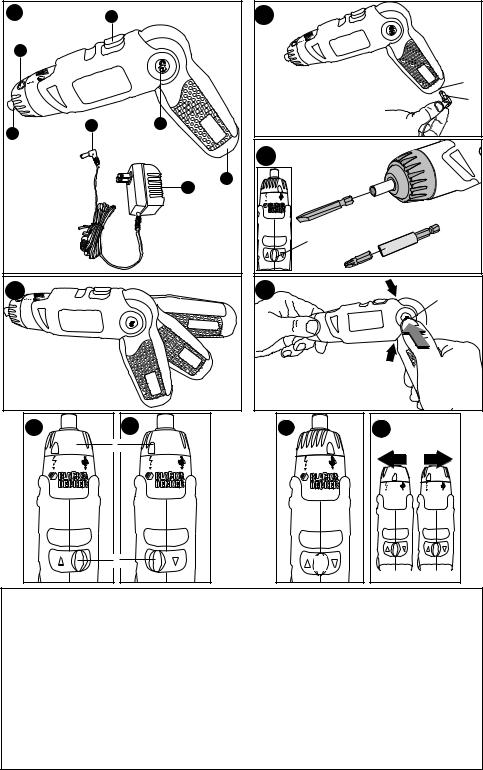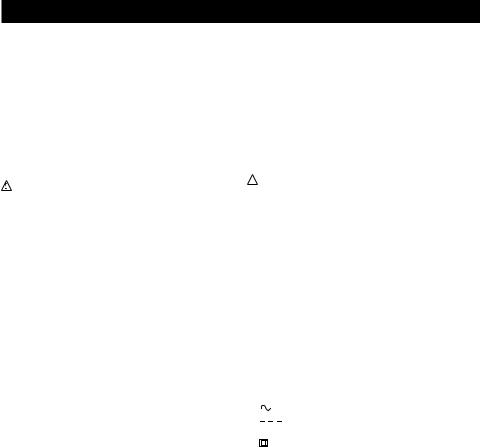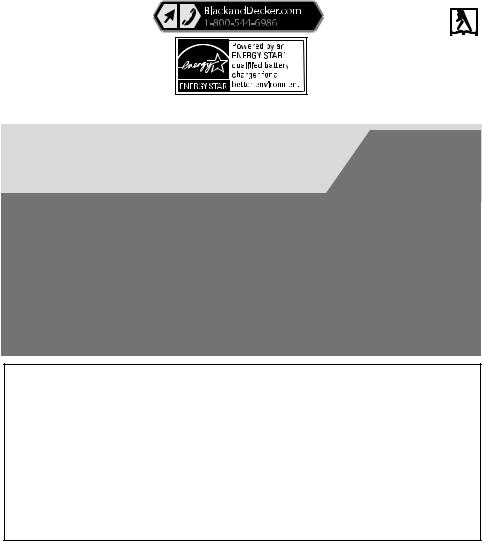Black & Decker Li200, LI2000 User Manual

Lithium pivotdriver
INSTRUCTION MANUAL
Catalog Number
Li2000
Thank you for choosing Black & Decker! To register your new product, go to www.BlackandDecker.com/NewOwner
Please read before retuRNINg this pRODUCT for aNy reasON.
If you have a question or experience a problem with your Black & Decker purchase, go to http://www.blackanddecker.com/instantanswers
If you can’t find the answer or do not have access to the Internet,
call 1-800-544-6986 from 8 a.m. to 5 p.m. EST Mon. - Fri. to speak with an agent. Please have the catalog number available when you call.
Save this mANUAL for futURe reference.
VEA EL ESPANOL EN LA CONTRAPORTADA.
INSTRUCTIVO DE OPERACIÓN, CENTROS DE SERVICIO Y PÓLIZA DE GARANTÍA. ADVERTENCIA: LÉASE ESTE INSTRUCTIVO ANTES DE USAR EL PRODUCTO.

A |
1 |
|
B |
|
4 |
|
|
|
|
|
|
|
|
5 |
|
|
|
|
7 |
3 |
7 |
2 |
|
|
|
|
|
|
|
|
|
|
C |
|
|
|
6 |
5 |
|
|
|
|
|
|
|
|
|
|
1 |
D |
|
|
E |
2 |
|
|
|
|
|
F |
F1 |
|
G |
G1 |
|
4 |
|
|
|
|
1 |
|
|
1 |
SAFETY GUIDELINES - DEFINITIONS
It is important for you to read and understand this manual. The information it contains relates to protecting YOUR SAFETY and PREVENTING PROBLEMS. The symbols below are used to help you recognize this information.
 DANGER: Indicates an imminently hazardous situation which, if not avoided, will result in death or serious injury.
DANGER: Indicates an imminently hazardous situation which, if not avoided, will result in death or serious injury.
 WARNING: Indicates a potentially hazardous situation which, if not avoided, could result in death or serious injury.
WARNING: Indicates a potentially hazardous situation which, if not avoided, could result in death or serious injury.
 CAUTION: Indicates a potentially hazardous situation which, if not avoided, may result in minor or moderate injury.
CAUTION: Indicates a potentially hazardous situation which, if not avoided, may result in minor or moderate injury.
NOTICE: Used without the safety alert symbol indicates potentially hazardous situation which, if not avoided, may result in property damage.
2

general power tool safety warnings
WARNING: Read all safety warnings |
power tools may result in serious |
|
and all instructions. Failure to follow the |
personal injury. |
|
warnings and instructions may result in |
b) Use personal protective |
|
electric shock, fire and/or serious injury. |
equipment. Always wear eye |
|
Save all warnings and |
protection. Protective equipment |
|
instructions for future |
such as dust mask, nonskid safety |
|
reference |
shoes, hard hat, or hearing protection |
|
The term “power tool” in the warnings refers |
used for appropriate conditions will |
|
reduce personal injuries. |
||
to your mains-operated (corded) power tool |
||
c) Prevent unintentional starting. |
||
or battery-operated (cordless) power tool. |
||
Ensure the switch is in the off |
||
1) Work Area Safety |
||
position before connecting to power |
||
a) Keep work area clean and well lit. |
||
source and/ or battery pack, picking |
||
Cluttered or dark areas invite accidents. |
||
up or carrying the tool. Carrying |
||
b) Do not operate power tools in |
||
power tools with your finger on the |
||
explosive atmospheres, such as in the |
||
switch or energizing power tools that |
||
presence of flammable liquids, gases |
||
have the switch on invites accidents. |
||
or dust. Power tools create sparks which |
||
d) Remove any adjusting key or |
||
may ignite the dust or fumes. |
||
wrench before turning the power |
||
c) Keep children and bystanders |
||
tool on. A wrench or a key left |
||
away while operating a power tool. |
||
attached to a rotating part of the power |
||
Distractions can cause you to lose control. |
||
tool may result in personal injury. |
||
2) Electrical safety |
||
e) Do not overreach. Keep proper |
||
a) Power tool plugs must match the |
||
footing and balance at all times. |
||
outlet. Never modify the plug in any |
||
This enables better control of the |
||
way. Do not use any adapter plugs |
||
power tool in unexpected situations. |
||
with earthed (grounded) power |
||
f) Dress properly. Do not wear loose |
||
tools. Unmodified plugs and matching |
||
clothing or jewelry. Keep your hair, |
||
outlets will reduce risk of electric shock. |
||
clothing and gloves away from |
||
b) Avoid body contact with earthed or |
||
moving parts. Loose clothes, jewelry or |
||
grounded surfaces such as pipes, |
||
long hair can be caught in moving parts. |
||
radiators, ranges and refrigerators. |
||
g) If devices are provided for the |
||
There is an increased risk of electric |
||
connection of dust extraction and |
||
shock if your body is earthed or grounded. |
||
collection facilities, ensure these |
||
c) Do not expose power tools to rain or |
||
are connected and properly used. |
||
wet conditions. Water entering a power |
||
Use of dust collection can reduce |
||
tool will increase the risk of electric shock. |
||
dust-related hazards. |
||
d) Do not abuse the cord. Never use |
||
4) Power tool use and care |
||
the cord for carrying, pulling or |
||
a) Do not force the power tool. Use |
||
unplugging the power tool. Keep |
||
the correct power tool for your |
||
cord away from heat, oil, sharp |
||
application. The correct power tool |
||
edges or moving parts. Damaged or |
||
will do the job better and safer at the |
||
entangled cords increase the risk of |
||
rate for which it was designed. |
||
electric shock. |
||
b) Do not use the power tool if the |
||
e) When operating a power tool |
||
switch does not turn it on and |
||
outdoors, use an extension cord |
||
off. Any power tool that cannot |
||
suitable for outdoor use. Use of a |
||
be controlled with the switch is |
||
cord suitable for outdoor use reduces |
||
dangerous and must be repaired. |
||
the risk of electric shock. |
||
c) Disconnect the plug from the power |
||
f) If operating a power tool in a |
||
source and/or the battery pack from |
||
damp location is unavoidable, use |
||
the power tool before making any |
||
a ground fault circuit interrupter |
||
adjustments, changing accessories, |
||
(GFCI) protected supply. Use of a |
||
or storing power tools. Such preventive |
||
GFCI reduces the risk of electric shock. |
||
safety measures reduce the risk of |
||
3) Personal safety |
||
starting the power tool accidentally. |
||
a) Stay alert, watch what you are |
||
d) Store idle power tools out of the reach |
||
doing and use common sense |
||
of children and do not allow persons |
||
when operating a power tool. Do |
||
unfamiliar with the power tool or |
||
not use a power tool while you |
||
these instructions to operate the |
||
are tired or under the influence of |
||
power tool. Power tools are dangerous |
||
drugs, alcohol or medication. A |
||
in the hands of untrained users. |
||
moment of inattention while operating |
||
e) Maintain power tools. Check for |
||
|
3

misalignment or binding of moving parts, breakage of parts and any other condition that may affect the power tool’s operation. If damaged, have the power tool repaired before use. Many accidents are caused by poorly maintained power tools.
f) Keep cutting tools sharp and clean.
Properly maintained cutting tools with sharp cutting edges are less likely to bind and are easier to control.
g) Use the power tool, accessories and tool bits, etc. in accordance with these instructions, taking into account the working conditions and the work to be performed.
Use of the power tool for operations different from those intended could result in a hazardous situation.
5) Battery tool use and care a) Recharge only with the charger specified by the manufacturer. A
charger that is suitable for one type of battery pack may create a risk of fire when used with another battery pack.
b)Use power tools only with specifically designated battery packs. Use of any other battery packs may create a risk of injury and fire.
c)When battery pack is not in use, keep it away from other metal objects like paper clips, coins, keys, nails, screws, or other small metal objects that can make a connection from one terminal to another.
Shorting the battery terminals together may cause burns or a fire.
d)Under abusive conditions, liquid may be ejected from the battery, avoid contact. If contact accidentally occurs, flush with water. If liquid contacts eyes, additionally seek medical help. Liquid ejected from the battery may cause irritation or burns.
6)Service
a)Have your power tool serviced by a qualified repair person using only identical replacement parts. This will ensure that the safety of the power tool is maintained.
Specific Safety Rules
• Hold power tool by insulated gripping surfaces, when performing an operation where the fastener may contact hidden wiring. Fasteners contacting a “live” wire may make exposed metal parts of the power tool “live” and could give the operator an electric shock.
• Use clamps or another practical way to secure and support the workpiece to a stable platform. Holding the work by hand or against your body leaves it unstable and may lead to loss of control.
WARNING: Some dust created by power sanding, sawing, grinding, drilling, and other construction activities contains chemicals known to the State of California to cause cancer, birth defects or other reproductive harm. Some examples of these chemicals are:
• lead from lead-based paints,
• crystalline silica from bricks and cement and other masonry products, and
• arsenic and chromium from chemicallytreated lumber.
Your risk from these exposures varies, depending on how often you do this type of work. To reduce your exposure to these chemicals: work in a well ventilated area, and work with approved safety equipment, such as those dust masks that are specially designed to filter out microscopic particles.
• Avoid prolonged contact with dust from power sanding, sawing, grinding, drilling, and other construction activities. Wear protective clothing
and wash exposed areas with soap and water. Allowing dust to get into your mouth, eyes, or lay on the skin may
promote absorption of harmful chemicals.
 WARNING: Use of this tool can generate and/or disperse dust, which may cause serious and permanent respiratory or other injury. Always use NIOSH/OSHA approved respiratory protection appropriate for the dust exposure. Direct particles away from face and body.
WARNING: Use of this tool can generate and/or disperse dust, which may cause serious and permanent respiratory or other injury. Always use NIOSH/OSHA approved respiratory protection appropriate for the dust exposure. Direct particles away from face and body.
 WARNING: ALWAYS use safety glasses. everyday eye glasses are NOT safety glasses. Also use face or dust mask if cutting operation is dusty. ALWAYS WEAR CERTIFIED SAFETY EQUIPMENT:
WARNING: ALWAYS use safety glasses. everyday eye glasses are NOT safety glasses. Also use face or dust mask if cutting operation is dusty. ALWAYS WEAR CERTIFIED SAFETY EQUIPMENT:
• ANSI Z87.1 eye protection (CAN/CSA Z94.3)
• ANSI S12.6 (S3.19) hearing protection
• NIOSH/OSHA/MSHA respiratory protection
SYMBOLS |
|
|||
The label on your tool may include the |
||||
following symbols. |
volts |
|||
V.................................. |
|
|
||
A.................................. |
|
|
amperes |
|
Hz................................ |
|
|
hertz |
|
W................................. |
|
|
watts |
|
min............................... |
minutes |
|||
|
|
or AC....................... |
alternating current |
|
|
|
|
or DC.................. |
direct current |
no |
|
|||
|
|
no load speed |
||
|
........................................ |
|
|
Class II Construction |
 ................................. earthing terminal
................................. earthing terminal
4

.../min................................... |
|
safety alert symbol |
line voltage resulting in loss of power |
||||
|
revolutions per |
|
and overheating. The following table |
||||
|
|
minute |
|
shows the correct size to use depending |
|||
• When using an extension cord, be |
|
on cord length and nameplate ampere |
|||||
sure to use one heavy enough to carry |
rating. If in doubt, use the next heavier |
||||||
the current your product will draw. An |
|
gauge. The smaller the gauge number, |
|||||
undersized cord will cause a drop in |
|
the heavier the cord. |
|
|
|||
|
Recommended Minimum Wire Size for Extension Cords |
||||||
Total Length of Cord |
100 ft. |
125 ft. |
150 ft. |
175 ft. |
|||
25 ft. |
50 ft. |
75 ft. |
|||||
7.6 m |
15.2 m |
22.9 m |
30.5 m |
38.1 m |
45.7 m |
53.3 m |
|
Wire Size AWG |
16 |
16 |
14 |
14 |
12 |
|
|
18 |
18 |
|
|||||
 Safety warnings and instructions: batteries
Safety warnings and instructions: batteries
•Do not disassemble or open, drop (mechanical abuse), crush, bend or deform, puncture, or shred.
•Do not modify or remanufacture, attempt to insert foreign objects into the battery, immerse or expose to water or other liquids, or expose to fire, excessive heat including soldering irons, or put in microwave oven.
•Only use the battery / tool with a charging
system specified by the manufacturer/supplier.
• Do not short-circuit a battery or allow metallic or conductive objects to contact both battery terminals simultaneously.
• Dispose of used batteries promptly according to the manufacturer/supplier’s instructions.
• Improper battery use may result in a fire, explosion, or other hazard.
• Battery / tool usage by children should be supervised.
 safety warnings and instructions: Charging
safety warnings and instructions: Charging
1. This manual contains important safety and operating instructions.
2. Before using battery charger, read all instructions and cautionary warnings on battery charger and product using battery.
CAUTION: To reduce the risk of injury, use this charger only with this product. Batteries in other products may burst causing personal injury or damage.
3. Do not expose charger to rain or snow.
4. Use of an attachment not recommended or sold by Black & Decker may result in a risk of fire, electric shock, or injury to persons.
5. To reduce risk of damage to electric plug and cord, pull by plug rather than cord when disconnecting charger.
6. Make sure cord is located so that it will not be stepped on, tripped over, or
otherwise subjected to damage or stress. 7. An extension cord should not be used
unless absolutely necessary. Use of improper extension cord could result in a risk of fire, electric shock or electrocution.
8. Use only the supplied charger when charging your tool. The use of any other charger could damage the tool or
create a hazardous condition.
9. Use only one charger when charging.
10. Do not attempt to open the charger. There are no customer serviceable parts inside. Return to any authorized Black & Decker service center.
11. DO NOT incinerate the tool or batteries even if they are severely damaged or completely worn out. The batteries can explode in a fire. Toxic fumes and materials are created when lithium ion battery packs are burned.
12. Do not charge or use battery in explosive atmospheres, such as in the presence of flammable liquids, gases or dust. Inserting or removing the battery from the charger may ignite the dust or fumes.
13. If battery contents come into contact with the skin, immediately wash area with mild soap and water. If battery liquid gets into the eye, rinse water over the open eye for three minutes or until irritation ceases. If medical attention
is needed, the battery electrolyte is composed of a mixture of liquid organic carbonates and lithium salts.
 WARNING: Burn hazard. Battery liquid may be flammable if exposed to spark or flame.
WARNING: Burn hazard. Battery liquid may be flammable if exposed to spark or flame.
FUNCTIONAL DESCRIPTION (FIGURE A)
1) |
Forward/Reverse/Lock off slider |
5) |
Charger port |
2) |
Pivot release button |
6) |
Charger |
3) |
Hex spindle |
7) |
Charger plug |
4) |
Power / manual mode collar |
|
|
5

Charging Procedure
IMPORTANT: The batteries in your tool are not fully charged at the factory. Before attempting to charge them, thoroughly read all of the safety instructions.
• The charging socket (5) is keyed to lock out other chargers. Align the tab in the charger plug (7) with the key in the charging socket.
• Insert charger plug into the charging socket of the tool as shown in figure B.
• Plug the charger into any standard 120
Volt 60 Hz electrical outlet.
• Letthetoolchargeinitiallyforatleast16hours.
After the initial charge, your tool should be fully charged in 12 hours from a fully discharged condition. Recharge discharged batteries as soon as possible after use or battery life may be greatly diminished. For longest battery life, do not discharge batteries fully. It is recommended that the batteries be recharged after each use.
 WARNING: Do not use tool while it is connected to the charger.
WARNING: Do not use tool while it is connected to the charger.
 WARNING: Fire Hazard. When disconnecting the charger from the tool, be sure to unplug the charger from the outlet first, then disconnect the charger cord from the tool.
WARNING: Fire Hazard. When disconnecting the charger from the tool, be sure to unplug the charger from the outlet first, then disconnect the charger cord from the tool.
Important Charging Notes
1. Your tool was sent from the factory in an uncharged condition. Before
attempting to use it, it must be charged for at least 16 hours.
2. CAUTION: To reduce the risk of damage to the batteries, NEVER charge them in an air temperature below 40°F (4,5°C) or above 105°F (40,5°C). Also, NEVER charge them if the battery temperature is below 40°F (4,5°C) or above 105°F (40,5°C). Longest life and best performance occurs when batteries are charged with an air temperature of approximately 75°F (24°C).
3. While charging, the charger may hum and become warm to touch. This is a normal
condition and does not indicate a problem. 4. If the batteries do not charge properly—
(1) Check current at receptacle by plugging in a lamp or other appliance.
(2) Check to see if receptacle is connected to a light switch which turns power off when you turn out the lights.
(3) Check that the charger plug is fully inserted into the charger port on the tool. (4) If the receptacle is ok, and you do not get proper charging, take or send the tool and charger to your local Black & Decker service center. See Tools Electric in yellow pages.
5. The tool should be recharged when it fails to produce sufficient power on
jobs which were easily done previously. Battery life may be greatly diminished if batteries are discharged deeply. DO NOT CONTINUE using product with its batteries in a depleted condition.
Recharge discharged batteries promptly. 6. To maximize battery life:
a. Do not fully discharge batteries.
b. Fully recharge batteries after each use. c. Store tool in a location where
the surrounding air temperature is approximately 40°F - 75°F (4.5°C - 24°C). d. Disconnect charger from tool after charge is complete. WARNING: Fire Hazard. When disconnecting the charger from the tool, be sure to unplug the charger from the outlet first, then disconnect the charger cord from the tool.
Safety Warnings and
Instructions: Drilling WARNING: Tool may stall (if overloaded or improperly used) causing a twist. To reduce the risk of injury always expect the stall. Grip the tool firmly to control the twisting action and prevent loss of control which could cause personal injury. If a stall does occur,release the trigger immediately and determine the reason for the stall before re-starting.
Assembly and Adjustment
Inserting and removing bits (figure C)
• Before installing or removing bits, move
the forward/ reverse slider (1) to the center
“lock-off” position as shown in insert.
• To install a bit, insert it into the cavity in the hex spindle as shown in figure C.
• To remove the bit pull it straight out.
• For bit tips, use a bit tip extender as shown.
NOTE: Only hex end bits will fit in spindle.
PIVOTING THE TOOL Handle (FIGURES D, E)
• The handle of the tool can be pivoted into three positions for optimum versatility as shown in figure D.
• To pivot the tool handle, press the pivot release button (2) as shown in figure E.
• Release the button in any one of the two remaining locked positions. WARNING: Check to make sure tool handle is locked after pressing pivot release button and changing screwdriver positions.
WARNING:
• To avoid being pinched at the areas indicated with black arrows, hold the screwdriver at both ends and use your thumb to depress the pivot release button when changing positions.
6

• Do not use screwdriver as a pry bar in any |
• To avoid screwdriver being turned on |
position. |
accidentally, do not carry in your pocket. |
operating instructions
operating in power mode |
|
slider(1)tothecenter“lock-off”position. |
|
Forward |
• Insert the appropriate hex shank drill bit. |
||
• |
Rotate the collar (4) to the position marked |
• |
Select forward rotation. |
• |
as shown in figure F. |
|
NOTE: When drilling, the bit may become |
Slide the forward/reverse switch (1) to the |
|
disconnected from the spindle upon |
|
|
right, exposing the arrow pointing forward |
|
withdrawing it from the material. Should |
|
as shown in figure F. |
|
this occur, the bit can be removed by |
• Press the button on the switch and the tool will |
|
re-insertingthehexshankintothespindle |
|
|
run; release the button and the tool will stop. |
|
and running the tool in the reverse direction. |
Reverse |
General Drilling Tips |
||
• |
Rotate the collar (4) to the position marked |
• |
This tool is not recommended for drilling |
• |
as shown in figure F1. |
• |
in masonry. |
Slide the forward/reverse switch (1) to the |
Use sharp drill bits only. |
||
|
left, exposing the arrow pointing backward. |
• |
Drill bits for metal can be used for drilling |
• Press the button on the switch and the tool will |
|
holes in wood. These bits must be sharp |
|
|
run; release the button and the tool will stop. |
|
and should be pulled out frequently when |
Forward/Reverse/Lock-off Slider |
|
drilling to clear chips from the flutes. |
|
• When the forward / reverse slider (1) is in the |
• Support and secure work properly, as |
||
|
central position the tool is locked off to prevent |
|
instructed in the safety Instructions. |
|
accidental actuation or battery discharge. |
• Use appropriate and required safety |
|
operating in manual mode |
|
equipment, as instructed in the safety |
|
• |
Rotate the collar to the position marked |
|
instructions. |
• |
as shown in figure G. |
• Secure and maintain work area, as |
|
Use the tool as any conventional non- |
|
instructed in the safety instructions. |
|
|
powered screwdriver. When the forward / |
• Apply pressure in a straight line with the |
|
|
reverse slider (1) is in the central position |
|
bit. Use enough pressure to keep the |
|
the tool is locked off to prevent accidental |
|
bit biting but not so much as to stall the |
|
actuation or battery discharge. |
• |
motor or deflect the bit. |
|
NOTE: If the collar fails to move past the |
Holdthetoolfirmlytocontrolitstwistingaction. |
|
|
cental lock position to manual mode then |
• DO NOT CLICK THE TRIGGER OF A |
|
1. |
please see the following procedure: |
|
STALLED TOOL OFF AND ON IN AN |
Turn clutch collar to Power Mode . |
|
ATTEMPT TO START IT. DAMAGE TO |
|
2. |
(figure G1) |
|
THE TOOL CAN RESULT. |
Run the unit. |
• Minimize stalling on breakthrough by |
||
4. |
Turn clutch collar to Manual Mode . |
|
reducing pressure and slowly drilling |
|
(figure G1) |
|
through last part of hole. |
Screw driving |
• Keepthemotorrunningwhile pulling thebitout |
||
• Beforeinstallingbits,movetheforward/reverse |
• |
of a drilled hole. This will help reduce jamming. |
|
• |
slider(1)tothecenter“lock-off”position. |
Make sure switch turns tool on and off. |
|
Insert the appropriate hex shank |
|
WARNING: It is important to support |
|
|
screwdriver bit into the spindle. |
|
work properly and to hold the tool firmly to |
• Select forward or reverse rotation. |
|
prevent loss of control which could cause |
|
Drilling |
|
personal injury. |
|
• Beforeinstallingbits,movetheforward/reverse |
|
|
|
Maintenance
Use only mild soap and damp cloth to clean the tool. Never let any liquid get inside the tool; never immerse any part of the tool into a liquid.
IMPORTANT: To assure product SAFETY and RELIABILITY, repairs, maintenance
and adjustment (other than those listed in this manual) should be performed by
authorized service centers or other qualified service personnel, always using identical replacement parts.
BATTERY REMOVAL AND DISPOSAL
This product uses lithium-ion rechargeable and recyclable batteries. When the batteries no longer hold a charge, they should be removed from the product and recycled. They must not be incinerated or composited.
The batteries can be taken for disposal to a Black & Decker, Company-Owned or Authorized Service Center. Some local retailers are also participating in a national recycling program (see “RBRC™
7

Seal”). Call your local retailer for details.
If you bring the batteries to a Black &
Decker Company-Owned or Authorized
Service Center, the Center will arrange to recycle old batteries. Or, contact your local municipality for proper disposal instructions in your city/town.
To remove the battery pack for disposal:
1.) First, before attempting to disassemble the product, turn it on and run it in either
direction until it stops to ensure a complete discharge of the batteries.
2.) Remove the screws in the product housing and lift the housing half from the tool. 3.) Disconnect the terminal clips from the batteries and lift the batteries out.
4.) Place the battery in suitable packaging to prevent a short circuit of the battery terminals. 5.) Dispose of batteries as per recommended guidelines.
Troubleshooting
Problem |
Possible Cause |
Possible Solution |
• Battery will not charge. |
• Charger not plugged into |
• Plug charger into a |
|
a working outlet. |
working outlet. Refer to |
|
|
“Important Charging |
|
|
Notes” for more details. |
|
|
• Check current at |
|
|
receptacle by plugging in |
|
|
a lamp or other appliance. |
|
|
• Check to see if |
|
|
receptacle is connected to |
|
|
a light switch which turns |
|
|
power off when you turn |
|
• Charger jack not fully plugged |
out the lights. |
|
• Check to be sure |
|
|
into tool charging socket. |
charger plug is fully |
|
|
inserted into tool |
|
|
charging socket. |
For assistance with your product, visit our website www.blackanddecker.com for the location of the service center nearest you or call the BLACK & DECKER help line at
1-800-544-6986.
Accessories
Recommended accessories for use with your tool are available from your local dealer or authorized service center. If you need assistance regarding accessories,
please call: 1-800-544-6986.
 WARNING: The use of any accessory not recommended for use with this tool could be hazardous.
WARNING: The use of any accessory not recommended for use with this tool could be hazardous.
The RBRC™ Seal
The RBRC™ (Rechargeable 
 Battery Recycling Corporation) Seal
Battery Recycling Corporation) Seal 

 on the lithium-ion battery (or battery
on the lithium-ion battery (or battery 


 pack) indicates that the costs to
pack) indicates that the costs to 
 recycle the battery (or battery pack) at the end of its useful life have already been paid by Black & Decker. In some areas, it is illegal to place spent lithium-ion batteries in the trash or municipal solid waste stream and the RBRC program provides an environmentally conscious alternative.
recycle the battery (or battery pack) at the end of its useful life have already been paid by Black & Decker. In some areas, it is illegal to place spent lithium-ion batteries in the trash or municipal solid waste stream and the RBRC program provides an environmentally conscious alternative.
RBRC in cooperation with Black & Decker and other battery users, has established programs in the United States and Canada to facilitate the collection of spent lithium-ion batteries. Help protect our environment and conserve natural resources by returning the tool to an authorized Black & Decker service center for recycling. You may also contact your local recycling center for information on where to drop off the spent battery, or call
1-800-8-BATTERY.
Service Information
All Black & Decker Service Centers are staffed with trained personnel to provide customers with efficient and reliable power tool service. Whether you need technical advice, repair, or genuine factory replacement
parts, contact the Black & Decker location nearest you. To find your local service location, refer to the yellow page directory under “Tools—Electric” or call: 1-800-544-
6986 or visit www.blackanddecker.com
Full Two-Year Home Use Warranty
Black & Decker (U.S.) Inc. warrants this product for two years against any defects in material or workmanship. The defective product will be replaced or repaired at no charge in either of two ways.
The first, which will result in exchanges only, is to return the product to the retailer from whom it was purchased (provided that the store is a participating retailer). Returns should be made within the time period of
8

the retailer’s policy for exchanges (usually 30 to 90 days after the sale). Proof of purchase may be required. Please check with the retailer for their specific return policy regarding returns that are beyond the time set for exchanges.
The second option is to take or send the product (prepaid) to a Black & Decker owned or authorized Service Center for repair or replacement at our option. Proof of purchase may be required. Black & Decker owned and authorized Service Centers are listed under “Tools-Electric” in the yellow pages of the phone directory and on our website www.blackanddecker.com.
This warranty does not apply to accessories. This warranty gives you
Imported by:
Black & Decker (U.S.) Inc.,
701 E. Joppa Rd.
Towson, MD 21286 U.S.A.
specific legal rights and you may have other rights which vary from state to state. Should you have any questions, contact the manager of your nearest Black & Decker Service Center. This product is not intended for commercial use.
LATIN AMERICA: This warranty does not apply to products sold in Latin America. For products sold in Latin America, check country specific warranty information contained in the packaging, call the local company or see the website for warranty information.
free warning label replacement: If your warning labels become illegible or are missing, call 1-800- 544-6986 for a free replacement.
See ‘Tools-Electric’
– Yellow Pages – for Service & Sales
VISSEUSE AVEC TÊTE PIVOTANTE AU LITHIUM
mode d’emploi
Numéro de catalogue : Li2000
Merci d’avoir choisi Black & Decker!
Consulter le site Web www.BlackandDecker.com/NewOwner pour enregistrer votre nouveau produit. à LIRE avant de retourner ce produit pour quelque raison que ce soit :
Si des questions ou des problèmes surgissent après l’achat d’un produit Black & Decker, consulter le site Web www.blackanddecker.com/instantanswers
pour obtenir des réponses instantanément 24 heures par jour.
Si la réponse est introuvable ou en l’absence d’accès à l’Internet, composer le
1 800 544-6986 de 8 h à 17 h HNE, du lundi au vendredi, pour parler avec un agent.
Prière d’avoir le numéro de catalogue sous la main lors de l’appel.
Conserver ce manuel pour un usage ultérieur.
lignes directrices en matière de sécurité - définitionsIl est important que vous lisiez et compreniez ce mode d’emploi. Les informations qu’il contient concernent VOTRE SÉCURITÉ et visent à ÉVITER TOUT PROBLÈME. Les symboles ci-dessous servent à vous aider à reconnaître cette information.
 DANGER : Indique une situation dangereuse imminente qui, si elle n’est pas évitée, causera la mort ou des graves blessures.
DANGER : Indique une situation dangereuse imminente qui, si elle n’est pas évitée, causera la mort ou des graves blessures.
 AVERTISSEMENT : Indique une situation potentiellement dangereuse qui, si elle n’est pas évitée, pourrait causer la mort ou de graves blessures.
AVERTISSEMENT : Indique une situation potentiellement dangereuse qui, si elle n’est pas évitée, pourrait causer la mort ou de graves blessures.
 MISE EN GARDE : Indique une situation potentiellement dangereuse qui, si elle n’est pas évitée, pourrait causer des blessures mineures ou modérées.
MISE EN GARDE : Indique une situation potentiellement dangereuse qui, si elle n’est pas évitée, pourrait causer des blessures mineures ou modérées.
AVIS : Utilisé sans le symbole d’alerte à la sécurité, indique une situationvpotentiellement dangereuse qui, si elle n’est pas évitée, peut résulter en des dommages à la propriété.
9
